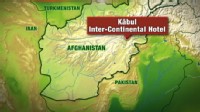The cheerleading squad for the Indian cricket team Pune Warriors takes a traditional-culture, fully clothed approach to motivate players and fans. It calls for complex hand waves and traditional dance steps in saris.

Cheerleaders perform during the Pune Warriors' match against Kings XI Punjab in Mumbai, India. The Warriors introduced their traditional-culture, fully clothed "cheer queens" this year. (Rajanish Kakade / Associated Press / April 10, 2011)
Reporting from New Delhi—
Can sari-clad "cheer queens" stand up to short-skirted pom-pom girls?
That's a question Indian cricket fans are pondering after a team here introduced a cheerleading squad wrapped head to toe in traditional garb, its members eschewing high kicks and splits for complex hand waves and traditional dance steps.
"The concept of cheer queens is an extraordinary way of showcasing our national artistic heritage to the world," says Abhijit Sarkar, director of the Pune Warriors.
Others say it's a nice idea, done somewhere else.
"If you want fine arts, go to a hall," said cricket columnist Ayaz Memon.
Cheerleading arrived in India three years ago with the inception of a shorter, more TV-friendly form of cricket, a three-hour version of a game that, in its purest form, lasts five days with breaks for tea.
To attract audiences to the glitzy new Indian Premier League, organizers drew on an age-old principle — sex sells — and introduced U.S.-style cheerleaders in bikinis, miniskirts and high boots.
Many male fans welcomed the idea. But right-wing, religious and feminist groups quickly condemned it as "vulgar," "walking porn" and "frivolous eye candy" in a nation where, Kama Sutra aside, sensuality is not frequently discussed or displayed in public.
The fact that at least half the cheerleaders were foreigners, including several members of the Washington Redskins cheerleading squad with short skirts and what the Hindustan Times described as "teeny-weeny blouses," only fueled the kerfuffle.
They're "worse than bar dancers," complained Maharashtra state minister Siddharam Mhetre. "Mothers and daughters watch these matches and it does not look nice."
In a bid to appeal to the high-brow side of the sports-fan brain, the Warriors, an expansion team based in Pune, this year introduced its traditional-culture, fully clothed approach to crowd excitement.
A few hours before the last Pune Warriors match of the season, cheer queen Jennifer Cray, 27, donned a maroon and white sari, waterproof makeup, hair extensions and intricate forehead jewelry. She and her colleagues juggle seven traditional dance forms and multiple costumes in a bid to encapsulate India's 5,000-year diversity before spectators of the 450-year-old game, all in heat that can reach 120 degrees.
On the opposite side of the field, Delhi Daredevils' cheerleaders leap and gyrate in blue tank tops, miniskirts and three-quarter Lycra shorts.
"It's really difficult sometimes," Cray said. "Compared to other cheerleaders, who look so comfortably dressed, it can be quite hot and uncomfortable. But the appreciation from Pune Warriors supporters makes up for it."
Nets, security guards, even moat-like barriers separate cheerleaders from occasionally rude, catcalling fans, which "brings the cricket arena uncomfortably close to a zoo," in the words of one critic.
Pune's path along the moral high road has received mixed reviews. Some welcome this Indian imprint on the glitzy foreign concept. "CheerQueens are much hotter in [saris] than bottle blondes in knickers," wrote socialite Shobhaa De on Twitter.
But even some dance purists aren't sold. Although young viewers may be exposed to traditional culture, the approach, they say, risks cheapening the ancient art.
"To just thoughtlessly put together styles with a fast-forward button is disrespectful," said Aditi Mangaldas, head of the Drishtikon Dance Foundation.
Sociologists say the debate reflects the gap between an increasingly sophisticated, brash and cosmopolitan India and a largely uneducated and conservative rural population
left behind.
League efforts to bridge this morality gap weren't helped by a scandal that saw Mumbai Indians cheerleader Gabriella Pasqualotto, a South African, fired after blogging about the after-game parties involving some of cricket's biggest names. "The guys treated us like pieces of meat," she told the South African Witness newspaper.
As cheerleading takes hold, many teams have found a middle ground, scaling back some of the most revealing outfits in favor of fuller clothes and tights beneath short skirts. With time, more foreign exposure and India's increasingly outrageous reality shows, the original shock value is also wearing off.
"At first it seemed cheeky and bawdy," said columnist Memon. "Now, it's become more naturalized and acceptable."
Even as the Pune Warriors vow to keep the candle lighted for tradition, few other teams in the league seem eager to follow suit. If anything, the Western cheerleader concept has spread to hockey and boxing events, TV programs and advertising, as well as Internet sites that allow you to direct how avatar cheerleaders leap and gyrate.
"It's Indian hypocrisy at its best," said Suhel Seth, head of Counselage India, a consulting firm. "This is a country of temples carved with erotica, that invented the Kama Sutra. Pretending to be squeamish about women is absurd."

















































































